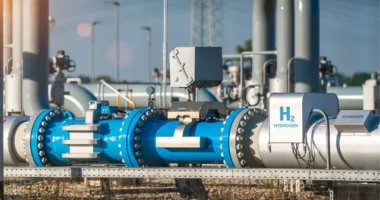The WindFloat Atlantic, the world’s first semi-submersible floating wind farm, has been a groundbreaking project in renewable energy. After four years of operation, it has generated over 320 GWh of electricity, providing clean energy to approximately 25,000 homes annually. Located off the coast of Portugal, the project exemplifies the future potential of floating wind technology, overcoming the challenges of deep-sea installations that traditional bottom-fixed turbines face.
Commissioned in 2020, the WindFloat Atlantic consists of three floating platforms, each equipped with an 8.4 MW Vestas turbine. These turbines, with blade diameters of 164 meters, are anchored to the seabed about 100 meters deep. The platforms are semi-submersible, allowing them to stabilize even in the harshest weather conditions, such as the 86 mph winds and 65-foot waves they endured in 2023 without disruption. This resilience makes floating wind farms like WindFloat Atlantic ideal for deeper waters where winds are stronger and more consistent than near the shore.

The innovative design of WindFloat Atlantic allows it to operate in locations that are otherwise unsuitable for conventional offshore turbines. Traditional wind farms are limited to waters up to 50-60 meters deep, while floating wind platforms like WindFloat can be placed in waters far deeper. This unlocks new areas for wind energy development, particularly in regions with deep coastal waters where wind speeds are higher and more reliable, boosting the overall efficiency of power generation.
One of the key advantages of the WindFloat platform is its semi-submersible design, which uses an active ballast system to remain stable in rough sea conditions. This unique construction has demonstrated high reliability, further proven by a 2 MW prototype that successfully operated from 2011 to 2016, even surviving extreme weather.
Floating wind farms are crucial in the global push towards renewable energy. Projects like WindFloat Atlantic represent a significant step forward in reducing reliance on fossil fuels, offering scalable solutions to harness the power of wind in deeper waters, which is essential for meeting international climate goals. Over the years, WindFloat has steadily improved its performance, producing 78 GWh in 2022 and 80 GWh in 2023, marking its success not just in energy output but also in technological robustness.
The success of WindFloat Atlantic has also fostered collaboration between various stakeholders, including Ocean Winds, a joint venture between EDP Renewables and ENGIE, which has been instrumental in pushing the project forward. As the world transitions to greener energy, the lessons learned from WindFloat Atlantic will likely inform future developments in floating wind technology, opening up more opportunities for renewable energy in areas where fixed wind turbines cannot be deployed.
In conclusion, WindFloat Atlantic serves as a pioneering model for floating offshore wind farms. Its ability to produce substantial energy while withstanding the challenges of the open sea illustrates the potential for scaling this technology globally. As the demand for clean energy continues to grow, projects like WindFloat Atlantic are not only showcasing innovative engineering but also playing a vital role in reducing global carbon emissions and paving the way for the future of renewable energy.
Image Credit : Windplus





